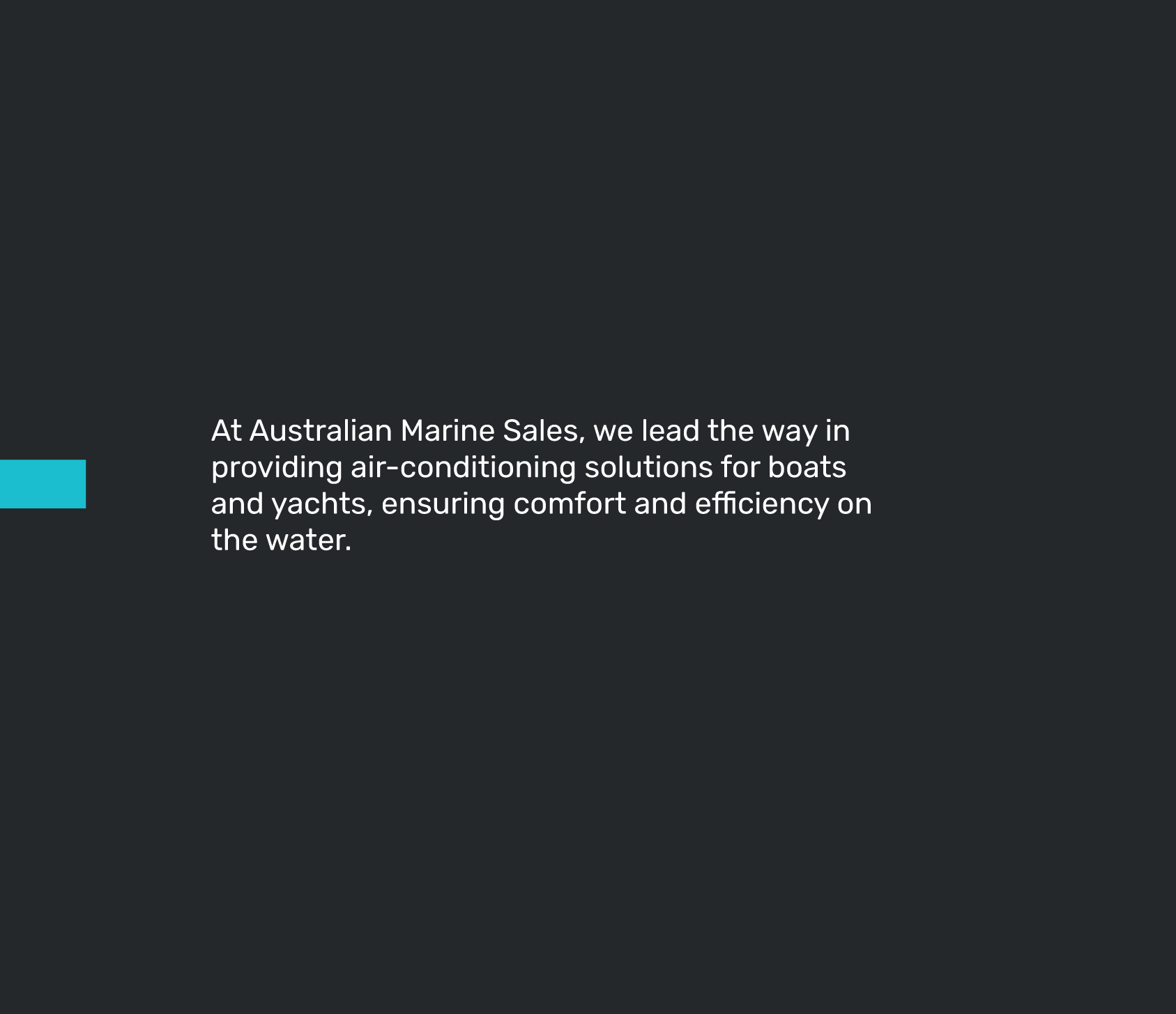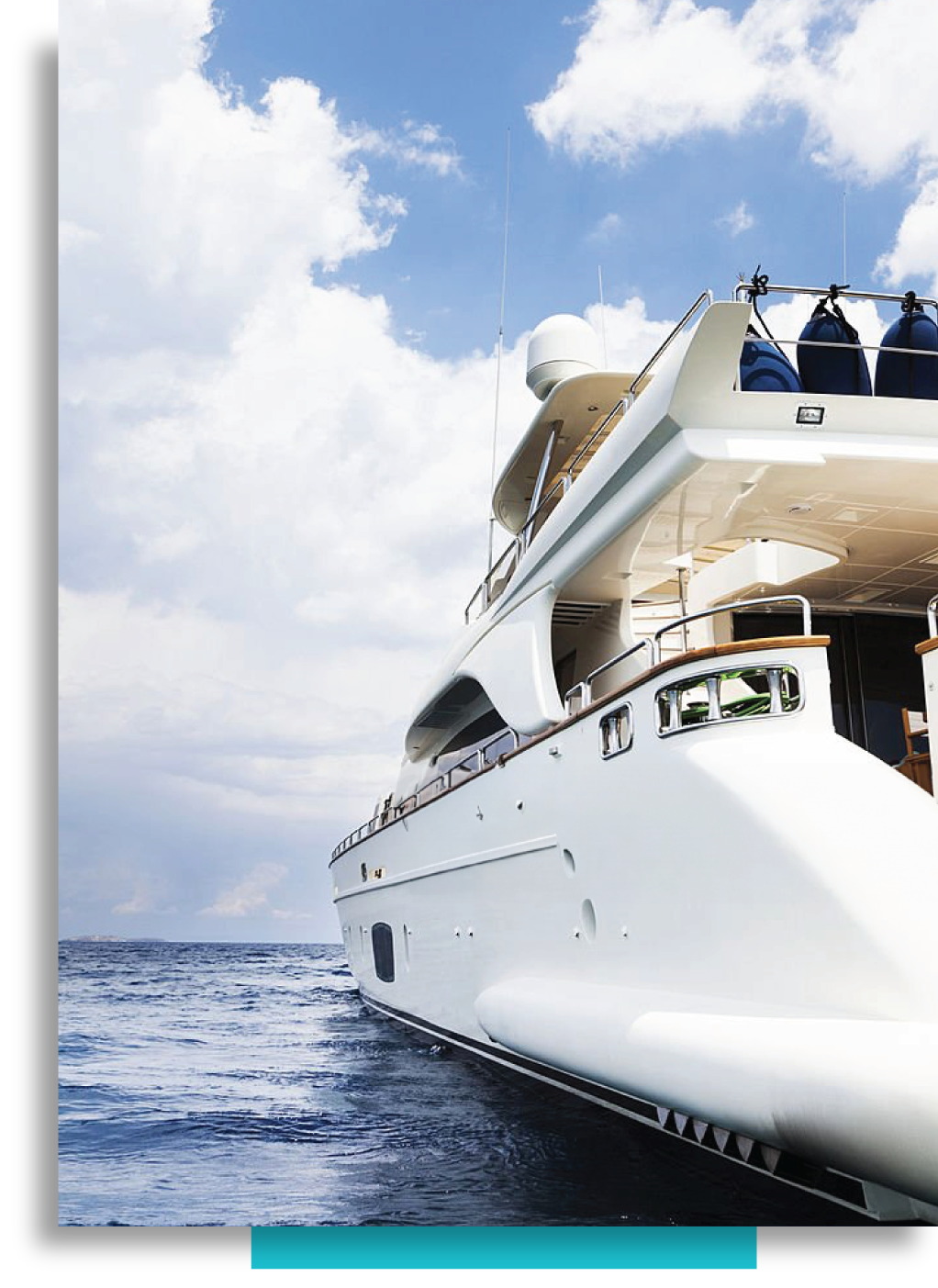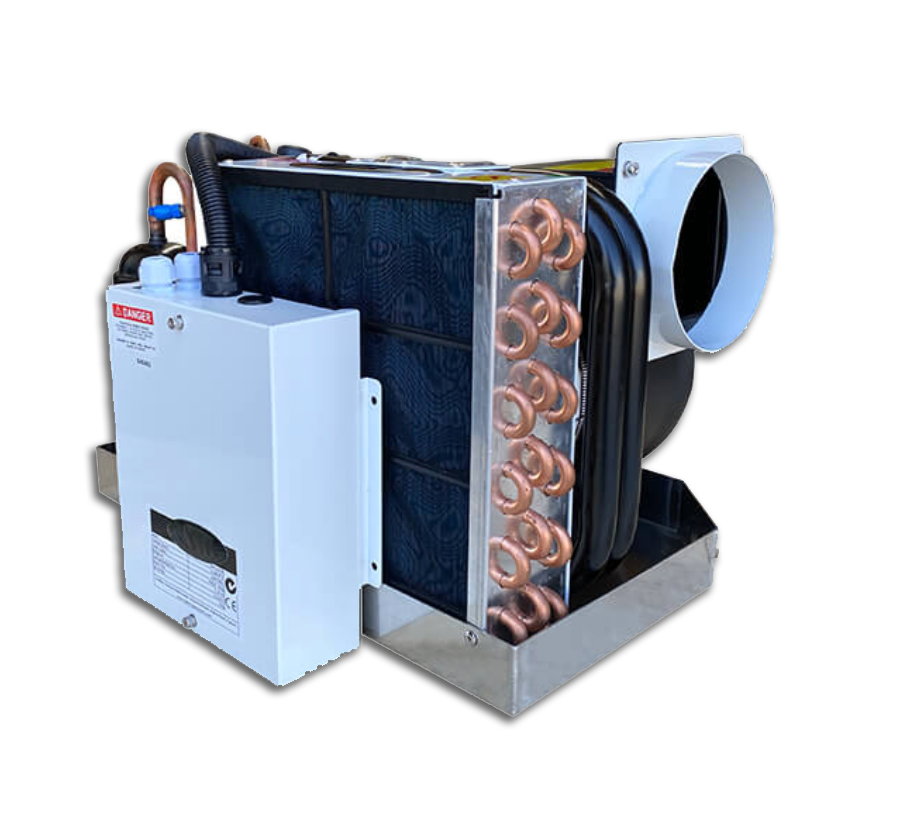Air Conditioning & Refrigeration
With our respected team of product, sales and service professionals, Australian Marine Sales is your ‘one-stop’ solution for all your boating needs, including expert installation services


Recreational Power & Sail Boats
Australian Marine Sales is your go-to destination for supplying and organising installation of marine air-conditioning systems for recreational power and sail vessels across Australia. In today’s maritime landscape, air-conditioning systems have become essential for vessels above 30 feet, ensuring a comfortable experience on the water, especially in the Australian climate.
We pride ourselves on continuous delivery, catering to vessels that lack marine air-conditioning or require replacement units. What sets us apart is our specialisation in marine air-conditioning, where we utilise seawater as the cooling circuit, a distinctive feature that differentiates it from residential and commercial systems. With a commitment to excellence and innovation, Australian Marine Sales stands as a leader in supplying and organising installation on yacht and boat marine air-conditioning systems, ensuring optimal comfort and performance for every voyage.

Air Condition and Refrigeration Types
Self Contained Air Conditioning | Split Systems air-conditioning | Chilled Water Systems | Air Handling & Treatment | Seawater pumps and circulation pumps

Commercial Vessels
Australian Marine Sales is your trusted partner for supplying and organising installation of marine air-conditioning systems tailored specifically for commercial vessels across Australia. Whether it’s charter vessels for private use, government vessels, or commercial enterprises, we have the expertise to meet your needs.
Our focus on chilled water systems ensures efficient cooling solutions for vessels of all sizes. Typically, for vessels over 60 feet, our marine air-conditioning includes chiller units with strategically placed air handlers to ensure optimal comfort throughout the vessel. With our extensive experience and dedication to quality, Australian Marine Sales is your one-stop solution for all marine air-conditioning requirements. Contact us today to discuss your needs and let us handle the supply and installation process for you.
AMS Expert Team
Our expertise lies in tailored solutions, whether it’s providing single units for each bedroom or large chiller systems to cool the entire vessel efficiently. Our team guide you through the selection process, ensuring the perfect system based on your usage, application, and serviceability needs. Contact us today
Contact an AMS Expert Today
Phone: 1300 795 531

Essential Boat Air Conditioning and Refrigeration
Elevating Comfort on the Water
Maintaining a comfortable climate aboard your boat is crucial whether setting sail for a short voyage or embarking on an extended journey. Air conditioning and refrigeration are two systems at the heart of this comfort, offering a respite from the heat and ensuring your provisions remain fresh throughout your trip. For many boat owners, installing a dependable air conditioner and refrigeration unit is paramount for a pleasant and sustainable maritime lifestyle.
Choosing the proper air conditioning and refrigeration systems for your vessel involves understanding the unique challenges of the marine environment. The saltwater and sun exposure, along with limited space and power constraints, require specialised equipment that can withstand these conditions. Additionally, proper installation and regular maintenance are vital in ensuring these systems perform efficiently and reliably over time.
Key Takeaways
Effective climate control on boats hinges on reliable air conditioning and refrigeration systems.
The selection and installation of these systems require consideration of marine-specific challenges.
Regular maintenance ensures the long-term efficiency and performance of boat climate systems.

Understanding Boat Air Conditioning Systems
Marine air conditioning systems provide essential cooling and comfort on your vessel. Proper operation depends on understanding their components and the different types available.
Components and Functionality
Your boat’s air conditioning system is comprised of several main components that work together to remove heat and humidity. At its core are a compressor, condenser, evaporator, and refrigerant circulating through the system.
- Compressor: This is the heart of your air conditioning system. It pressurises the refrigerant, which absorbs the heat from inside the cabin.
- Condenser: As the refrigerant is pumped through the condenser, usually outside the living spaces, it releases the absorbed heat into the air or surrounding water.
- Evaporator: Inside the cabin, the evaporator allows the refrigerant to expand and cool, pulling heat from the air and lowering the temperature inside your boat.
- Refrigerant: This specialised fluid is imperative for transferring heat. It circulates throughout the marine air conditioning system, alternately absorbing and releasing heat as it changes from liquid to gas.
Types of Marine Air Conditioners
In the world of marine air conditioners, you will generally encounter two main types:
1.
Self-contained Units: These are compact and ideal for small to medium-sized boats. They are typically easier to install and locate within the areas in which they cool.
2.
Split Systems: These systems separate the condenser and evaporator into different units. This allows for more flexible installation options and can benefit larger vessels requiring multiple cooling zones.
Understanding the specifics of these systems ensures you select the right air conditioner for your vessel and can maintain a comfortable climate on board.
Key Features of Marine Refrigeration Units
When selecting a marine refrigeration unit, you must consider the cooling capacities to match your requirements and understand the energy implications, which are pivotal for long-term efficiency and performance.
Cooling Capacities and Size Considerations
Your marine refrigerator’s capacity should align with your storage needs and space limitations. Size matters; a larger unit provides ample room but demands more power, whereas a compact unit saves energy at the expense of storage space.
- Small Units: ideal for day trips or smaller vessels with limited space
- Medium Units: suits weekend boaters with moderate storage needs
- Large Units: necessary for long voyages or commercial vessels
Energy Efficiency and Power Consumption
The efficiency of a refrigeration unit is an important aspect as it affects your vessel’s overall power consumption. Energy-efficient units use less power, which is paramount for long trips. Your power source influences your choice:
- Battery-powered: suitable for smaller boats with less demand on cooling
- Shore power hookup: feasible when frequently docking at marinas
- Solar panels: complement units on sustainable voyages
Units should exhibit high-efficiency ratings to ensure less draw on the vessel’s power reserves. Multi-speed compressors and insulation quality directly impact power efficiency.
Installation and Setup
Correct installation and setup are vital for optimizing your boat’s air conditioning and refrigeration system. These components will ensure a comfortable cabin environment and reliable preservation of perishables.
Choosing the Right Location
When selecting the location for your boat’s air conditioning and refrigeration systems, prioritise areas with good ventilation and minimal exposure to direct sunlight. This will facilitate the efficient functioning and longevity of the systems. The air conditioner condenser should be mounted in a spot where it can easily discharge warm air outside the cabin, while the refrigeration unit should be in a place that’s convenient for access yet out of the way of heavy foot traffic.
Professional Installation Vs. DIY
Professional Installation: Engaging a certified technician to install your system can guarantee a secure and optimal setup. They will ensure all components are fitted correctly and in accordance with maritime regulations. They can handle complex tasks such as ducting, electrical connections, and refrigerant handling.
DIY Installation: If you are experienced with boat systems and possess the necessary tools, DIY installation can be a cost-saving option. You must familiarise yourself with the manufacturer’s guidelines and maritime installation standards, including:
- Secure mounting to prevent movement due to vibrations or rough seas
- Correct wiring to the boat’s electrical system, adhering to safety standards
- Adequate insulation and sealing to maximise efficiency
Advice: If you choose the DIY route, consult with experts or refer to detailed manuals, as incorrect installation can lead to system failure and potential safety risks.

Climate Control and Temperature Regulation
Effective management of your boat’s internal environment hinges on two critical components: the thermostat and climate control systems. Properly configuring these systems ensures a comfortable and safe journey by maintaining the right temperature and circulation onboard.
Thermostats and Controls
Your boat’s thermostat acts as the central hub for temperature regulation. It allows you to set the desired temperature to ensure comfort in varying weather conditions. Modern thermostats offer digital interfaces with precise control over the heating, cooling, and ventilation systems. They typically include programmable settings to adjust temperatures for different times of the day or specific zones within the boat.
- Select a thermostat with straightforward controls and clear displays for ease of use.
- Remember to periodically check for software updates if your thermostat is digital, ensuring the latest features and fixes are in place.
Maintaining Optimal Conditions
Circulation is key when maintaining an even temperature throughout your boat. You must ensure that air can flow freely, without obstructions, so that cool or heated air reaches all areas effectively.
- Utilise fans or built-in air ducts to promote consistent air movement.
- Periodic maintenance of your boat’s air conditioning and refrigeration systems is essential to sustain peak efficiency and reliability.
- Regular cleaning of filters and checking for any potential leaks will preserve the optimal functionality of your systems.
Adhering to these guidelines helps safeguard against fluctuations in temperature, providing a stable and enjoyable climate onboard.
Maintenance and Troubleshooting
Proper maintenance and effective troubleshooting can significantly extend the life of your boat’s air conditioning and refrigeration systems. These systems require regular attention to operate efficiently and avoid costly repairs.
Regular Maintenance Schedule
Monthly Checks
- Visual Inspection: Examine hoses and connections for signs of wear or leaks.
- Filter Cleaning: Clean or replace air filters to ensure unobstructed airflow.
- Drain Pans and Tubes: Make sure they are clear of debris to prevent clogs and overflows.
Biannual Service
- Coolant Level: Inspect and top up refrigerant levels as needed, but only if you are certified to do so.
- System Operation: Test the system to monitor cooling efficiency.
- Thermostat Calibration: Verify the accuracy of the control system.
Identifying Common Issues
Reduced Cooling Capacity or Airflow
- Faulty Compressor: Check for unusual noises or failure to start.
- Clogged Filters or Coils: Clean or replace as necessary.
- Leaks: Inspect for refrigerant leaks that require professional repair.
Persistent Odours or Noises
- Mould Growth: Clean coils and surfaces where moisture can accumulate.
- Loose Components: Tighten any rattling or vibrating parts.
- By following a regular maintenance schedule and promptly addressing these common issues, you will greatly reduce the risk of system failure and ensure reliable performance from your boat’s air conditioning and refrigeration systems.
Accessorising Your Boat’s Climate Systems
Upgrading your boat’s climate control systems facilitates a more efficient and comfortable environment. Targeted adjustments to ventilation and insulation can yield significant improvements in temperature regulation.
Ventilation Enhancements
Improving your boat’s ventilation is crucial for maintaining air quality and temperature. You can upgrade your system with solar-powered vents that expel hot air without draining your boat’s battery. Additionally, consider installing reversible fans that can either introduce fresh air or expel stale air, depending on your needs.
- Solar Vents: harness the sun’s energy to operate fans; highly effective in sunny conditions without drawing on your main power supply
- Reversible Fans: offer flexibility to either draw in cool air or remove warm air; can be manually or thermostatically controlled to suit your preference
Adding Insulation and Seals
Enhancing your boat’s insulation affects the efficiency of both cooling and heating systems. Applying marine-grade insulation to the hull and sealing any gaps with quality sealants prevents thermal exchange with the external environment.
- Duct Insulation: Wrapping ducts with insulating material helps maintain the desired temperature as air travels through the system.
- Marine-grade reflective foil: reflects heat and resists moisture
- Foam insulation: offers a high R-value per inch of thickness
- Door and Window Seals: Inspect and replace the seals around doors and windows to prevent heat transfer and condensation.
- EPDM rubber: durable and resistant to weather influences
- Silicone sealants: provide a waterproof barrier and flexibility for different temperatures and movements
Boat Air Condition and Refrigeration Brand Overview
When considering marine air conditioning and refrigeration systems, you should focus on the range of products available from industry-leading brands and understand the warranty and support services they offer.
Comparing Major Manufacturers
To begin with, two prominent manufacturers, Dometic and Webasto, offer a variety of reliable products designed to perform in the challenging marine environment. Dometic prides itself on innovative air conditioning systems and refrigeration solutions for boats, ranging from compact units suitable for small vessels to robust systems for larger yachts. The brand is known for its high-quality build and advanced technology integration, such as energy-efficient cooling systems and low-noise operation.
Webasto, on the other hand, is synonymous with durable heating and cooling solutions, including marine air conditioning and refrigeration. Their offerings are adaptable to various boat sizes and include features to enhance user convenience, such as smart controls and self-contained units.
- Dometic
- Air Conditioning: Capella, Cuddy II, DTU series
- Refrigeration: CoolMatic CRX, CoolFreeze CFX series
- Webasto
- Air Conditioning: FCF Platinum series, BlueCool C-series
- Refrigeration: Isotherm Cruise, Drawer units
Here’s a quick comparison to help you assess:
Feature
Air Conditioner Efficiency
Refrigeration Technology
Option Variety
Noise Level
Energy Saving
Dometic
High (low power consumption models)
Advanced compressor technology
Extensive; for all boat sizes
Low
Emphasis on efficiency
Webasto
Moderate to high
Reliable and robust compressor systems
Broad; flexible installation
Low to moderate
Energy-conscious designs
Understanding Warranty and Support Options
The warranty and support policies that accompany your marine air conditioning and refrigeration systems can be imperative in the event of technical difficulties or product issues. It’s important to read the warranty specifics to ensure you’re covered for potential problems.
Dometic typically offers a two-year warranty on their products, with the option to extend for an additional year of protection. Their support system includes authorised service agents and access to customer service for troubleshooting and advice.
Webasto also provides a two-year warranty for its products, and like Dometic, it has a network of dealers and service points globally to assist with any issues.
Brand
Dometic
Webasto
Warranty Length
2 years + 1 year extra
2 years
Support Network
Authorised service agents; help centre
Global network of dealers and service points
You must contact the brand or your supplier directly for the most current warranty conditions and to understand how they handle service cases, ensuring you have complete clarity before making your purchase.
Frequently Asked Questions
When considering marine air conditioning and refrigeration, you are likely to have several questions. Here are some of the most common ones addressed to assist in making informed decisions.
How do I install a marine air conditioner on my boat?
To install a marine air conditioner on your boat, select a suitable location, ensure proper ventilation, and connect it to the water and power systems. Professional installation is recommended to avoid potential safety hazards and ensure efficient operation.
What are the cost implications of installing a boat air conditioning system?
The cost of installing an air conditioning system on your boat varies based on the size and type of the unit, brand, installation complexity, and additional components required. You must budget for the unit, installation services, and potential electrical system upgrades.
Are portable air conditioners a viable option for marine use?
Portable air conditioners can be used on boats but are typically less efficient than fixed systems. Ensure the model you choose suits marine environments, can be securely positioned, and won’t overtax your boat’s power supply.
How does marine refrigeration differ from standard refrigeration systems?
Marine refrigeration systems are designed to withstand harsh marine conditions, operate on a boat’s power supply, and fit within limited space. They often have more robust construction and insulation to maintain efficiency in a fluctuating environment.
Can a boat’s electrical system support an air conditioning unit through an inverter?
Your boat’s electrical system can support an air conditioning unit with an inverter, provided the inverter and battery bank have sufficient capacity. Check the power requirements of the air conditioner and consult with an electrician to ensure compatibility.
What factors should be considered when choosing a marine air conditioner?
Consider the boat’s size, available space for installation, power supply, cooling capacity, energy efficiency, noise levels, and your specific climate needs. Durability and corrosion resistance are also critical factors for marine air conditioners.
Thinking of selling your boat
Talk to us about listing and marketing your boat using our database of serious boating enthusiasts

